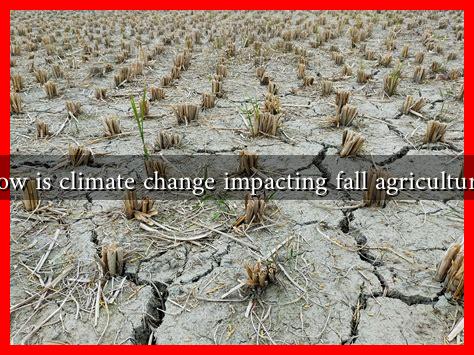-
Table of Contents
How is Climate Change Impacting Fall Agriculture?
Climate change is one of the most pressing issues of our time, affecting various sectors, including agriculture. As the planet warms, the implications for fall agriculture are becoming increasingly evident. Farmers are facing a myriad of challenges that threaten their livelihoods and food security. This article explores how climate change is impacting fall agriculture, highlighting key factors such as temperature fluctuations, changing precipitation patterns, and pest dynamics.
Temperature Fluctuations: A Double-Edged Sword
One of the most significant impacts of climate change is the increase in average temperatures. This rise can have both positive and negative effects on fall agriculture.
- Extended Growing Seasons: Warmer temperatures can lead to longer growing seasons, allowing farmers to plant crops earlier in the spring and harvest later in the fall. For instance, in regions like the Midwest United States, farmers have reported a shift in planting dates for corn and soybeans.
- Heat Stress: Conversely, extreme heat can stress crops, leading to reduced yields. For example, studies have shown that high temperatures during the critical pollination period of corn can significantly lower yields.
According to the National Oceanic and Atmospheric Administration (NOAA), average temperatures in the contiguous United States have increased by about 1.8°F since 1901, with projections suggesting further increases in the coming decades. This warming trend necessitates adaptive strategies for farmers to mitigate heat stress on crops.
Changing Precipitation Patterns: The Water Dilemma
Climate change is also altering precipitation patterns, leading to both droughts and floods, which can severely impact fall agriculture.
- Drought Conditions: Many regions are experiencing prolonged dry spells, which can lead to water shortages for irrigation. For instance, California has faced severe droughts in recent years, affecting the production of fall crops like grapes and almonds.
- Increased Flooding: On the other hand, some areas are experiencing heavier rainfall events, leading to flooding. This can damage crops and delay harvests. The Midwest has seen increased flooding incidents, which can wash away seeds and erode soil.
Farmers are now forced to invest in more efficient irrigation systems and adopt water conservation practices to cope with these changing conditions. The USDA has reported that implementing such practices can help mitigate the impacts of drought and improve crop resilience.
Pest Dynamics: A New Agricultural Challenge
Climate change is also influencing pest populations and their behaviors, posing additional challenges for fall agriculture.
- Increased Pest Populations: Warmer temperatures can lead to longer growing seasons for pests, allowing them to reproduce more rapidly. For example, the corn earworm, a significant pest for fall crops, has been observed to thrive in warmer conditions.
- Shifts in Pest Distribution: As temperatures rise, pests are migrating to new areas, potentially introducing diseases to crops that were previously unaffected. This shift can lead to increased pesticide use, raising production costs for farmers.
Farmers are now exploring integrated pest management strategies to combat these challenges, focusing on sustainable practices that minimize chemical use while effectively managing pest populations.
Case Studies: Real-World Impacts
Several case studies illustrate the real-world impacts of climate change on fall agriculture:
- Midwestern Corn Production: A study by the University of Illinois found that rising temperatures could reduce corn yields by up to 30% by 2050 if no adaptive measures are taken.
- California Wine Industry: The California wine industry is experiencing shifts in grape harvest dates due to changing climate conditions, with some vineyards moving to higher elevations to maintain quality.
Conclusion: Adapting to a Changing Climate
Climate change is undeniably reshaping fall agriculture, presenting both challenges and opportunities for farmers. As temperatures rise, precipitation patterns shift, and pest dynamics change, it is crucial for the agricultural sector to adapt. Farmers must embrace innovative practices, invest in technology, and collaborate with researchers to develop sustainable solutions. By doing so, they can not only mitigate the impacts of climate change but also ensure food security for future generations.
For more information on climate change and agriculture, you can visit the USDA Natural Resources Conservation Service.

